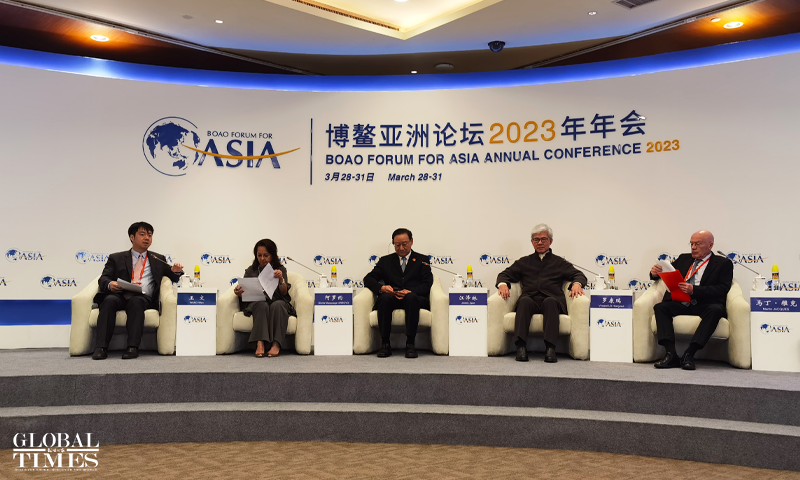
International observers attend a session themed "The Chinese Path to Modernization" at the Boao Forum for Asia Annual Conference 2023 in Boao, Hainan Province on March 29. Photo: Wang Wenwen/GT
The deciding factor of the success of Chinese modernization is the guiding hand of the Communist Party of China (CPC) which is meticulous and long-term in planning and execution, said former president of the Philippines Gloria Macapagal Arroyo during a panel discussion at the Boao Forum for Asia in Boao, South China's Hainan Province on Wednesday.
At the session themed "The Chinese Path to Modernization," Chinese and foreign experts shared ideas about their understanding of Chinese modernization.
The report to the 20th National Congress of the CPC in October last year noted that the central task of the CPC will be to lead the Chinese people of all ethnic groups in a concerted effort to realize the Second Centenary Goal of building China into a great modern socialist country in all respects and to advance the rejuvenation of the Chinese nation on all fronts through a Chinese path to modernization.
Chinese President Xi Jinping has on various occasions stressed the importance of correctly understanding and vigorously advancing Chinese modernization.
The former Philippine president believed that there are four secrets behind the success of Chinese modernization: a long-term vision of building socialism with Chinese characteristics; the strong will to implement the vision by CPC; recognition of state-of-art technology; and recognition of the value of infrastructure.
She noted that the Western path to modernization was often thought of as founded on colonialism, and China and the Philippines and many neighbors in Asia were the victims of the colonial behavior.
"That experience makes you understand that when China speaks of progress and modernization, it is often in the context of the community of shared future and common prosperity rather than exploitation in the colonial sense," Arroyo said.
Martin Jacques, a senior fellow at Cambridge University, said at the session discussion that there was only one modernity that was Western modernity. Since the middle of the 20th century, many countries have embarked on modernization, most remarkably of all China from 1949 and especially with the reform period after 1978.
"The nature of China's modernization in this period is a combination of borrowing inevitably from the experience of other countries further down the roads and a very indigenous adaptation of homegrown modernization," Jacques commented.
"China has continued with the dynamic of change and growth and constant reinvention. China does not get stuck and keeps moving. The mentality that China can't invent has shifted," he said.
China has taken the battle from the United States and become the leader of global development, and that has been an "extraordinary contribution," Jacques added.
Wednesday's session not only discussed the Chinese path to modernization in a broader sense, but also had Chinese officials talking about the concrete ways to achieve it in a down-to-earth manner.
Jiang Zelin, former deputy secretary-general of the State Council and chairman of the 12th CPPCC Jilin Provincial Committee, described China's modernization process as "scientific" and "precise."
"China set forth the 'Four Modernizations' to strengthen the fields of agriculture, industry, defense, and science and technology in the early days of the establishment of the People's Republic of China. Now as China develops, scientific technology has infiltrated into every aspect of society and brought about transformation across the economy, politics and people's way of life, so we constantly expand the areas of modernization," said Jiang.
Li Jianjun, Party chief of Northwest China Sichuan Province's Wenchuan county, which was struck by a magnitude-8.0 earthquake in 2008, shared with the audience how the county reconstructed and strived for modernization.
"We stressed three aspects: art, nature and talents. Art is important to push forward both material and spiritual richness, and Chinese modernization is one where material and spiritual richness coordinates with each other. It is also one where human and nature live harmoniously, so we pay attention to the environment and nature. Last but not least, we believe this process includes modernization of talent," Li said.




